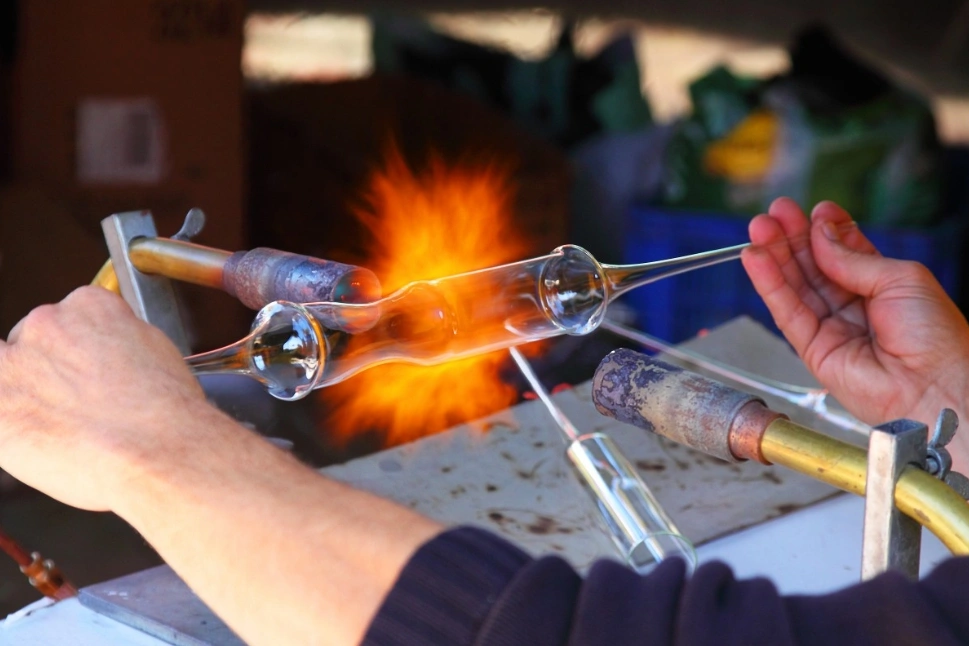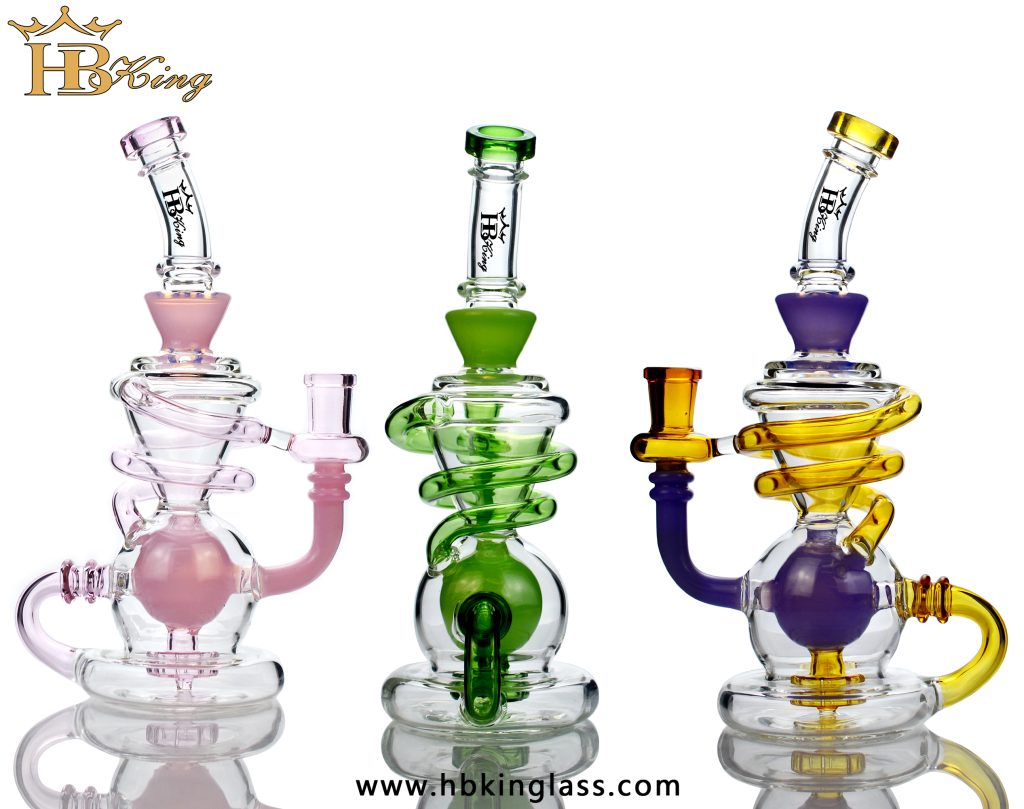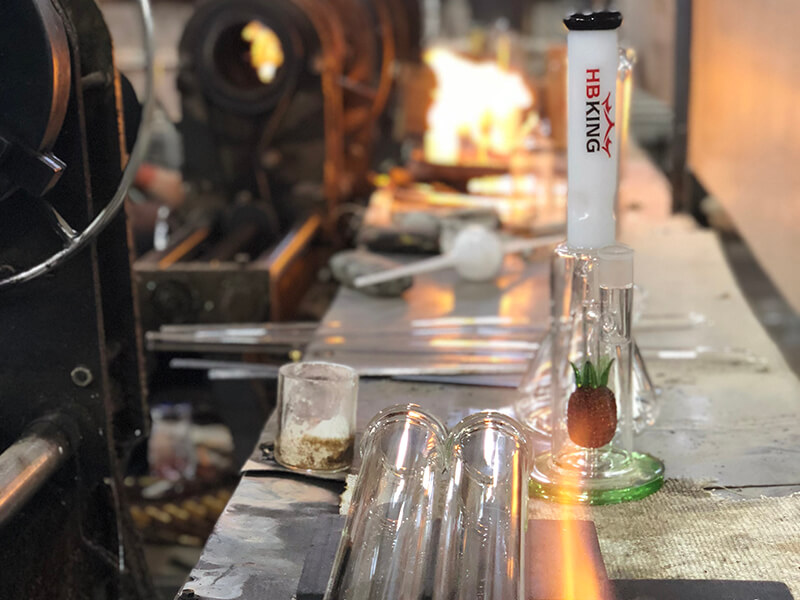Dive deep into the art of blowing glass bongs with this detailed guide that takes you through the traditional techniques and modern advancements in glassblowing. Perfect for enthusiasts and industry professionals, this guide equips you with the knowledge to appreciate and create high-quality glass bongs.
Blowing glass bongs involves skilled glassblowing techniques to shape borosilicate glass into functional, aesthetically pleasing smoking accessories, featuring elements like percolators and ice catchers for enhanced usability.
Understanding Glass Bongs
History and Evolution
The evolution of glass bongs mirrors broader cultural shifts. Initially simple and purely functional, these devices have morphed into complex artistic expressions that not only serve as smoking tools but also reflect societal attitudes towards cannabis and artistry over different eras.
The history of glass bongs intersects with the broader narrative of glassblowing, an ancient craft dating back to the Roman Empire. However, it wasn’t until the 20th century that bongs gained popularity in Western culture, particularly during the cultural upheaval of the 1960s and 1970s in the United States.
Today, glass bongs are celebrated not only for their functionality but also for their aesthetic appeal. Each piece tells a story of both cultural heritage and individual craftsmanship, reflecting both the personality of its maker and its user.
Materials Used in Glass Bongs
The primary material used in the production of high-quality glass bongs is borosilicate glass, similar to the Northstar Glass Rods as the standard for premium bongs, renowned for their quality. This material is prized for its durability and clarity:
- Durability: Resistant to thermal shock.
- Clarity: Allows users to see the smoke as it fills the chamber.
- Workability: Easier to mold and shape at high temperatures, making it ideal for creating intricate designs.
Other materials like soda-lime glass are also used but are less prevalent due to their lower resistance to heat, making borosilicate the industry standard for premium bongs.
Glass Blowing Techniques
Basic Techniques
Glass blowing transcends traditional craftsmanship, blending meticulous scientific precision with expansive creative flair. This dual nature challenges artists to innovate continually, pushing the boundaries of what can be achieved both aesthetically and functionally in glass bong design.
The process of blowing a glass bong starts with gathering molten glass on a blowpipe. This glass is then carefully blown into a bubble, which serves as the foundation for the bong’s water chamber. Here’s a brief rundown of the steps involved:
- Heating the Glass: The glassblower begins by placing a glob of molten glass on the end of a blowpipe, heating it in a furnace until it reaches a malleable state.
- Shaping the Bubble: Using tools and subtle air pressure from their own breath, the blower shapes the glass into a basic bubble. This bubble is then manipulated further to form the water chamber of the bong.
- Adding Components: Additional glass pieces such as the downstem, neck, and mouthpiece are attached. Each piece must be carefully joined while the glass is still hot and pliable.

Advanced Techniques
As glassblowers hone their skills, they can experiment with more advanced techniques to create bongs that are not only functional but also visually stunning. These include:
- Coloring Techniques: Incorporating colored glass can make each piece unique. Methods like fuming, where silver or gold is vaporized to bond with the glass surface, add iridescent effects.
- Sculptural Techniques: Some bongs are adorned with intricate glass sculptures that may mimic wildlife, fantasy creatures, or abstract forms.
- Percolators and Ice Catchers: Advanced bongs often include percolators to diffuse the smoke and ice catchers to cool it, enhancing the smoothness of the inhalation.
The creation of a glass bong is a delicate balance between art and technique, requiring both creative vision and meticulous control over the materials.
| Technique | Description | Purpose |
| Basic Techniques | Heating the glass: Molten glass is gathered on a blowpipe and heated in a furnace.
Shaping the bubble: The glass is blown into a bubble, forming the base of the bong. Adding components: Additional pieces like the downstem, neck, and mouthpiece are attached while the glass is hot. |
Creating the basic structure of the bong
|
| Advanced Techniques | Coloring Techniques (fuming for iridescence)
Sculptural Techniques Percolators for smoke diffusion Ice Catchers for smoke cooling |
Enhancing the bong’s aesthetics, improving smoke filtration and cooling
|
Types of Glass Bongs
Glass bongs come in a variety of shapes and sizes, each designed to suit different preferences and smoking styles. Here’s a closer look at some of the most popular types:
- Beaker Bongs: Shaped like a scientific beaker, these bongs have a wide base that provides stability and a larger water reservoir for better filtration and cooling of the smoke.
- Straight-Tube Bongs: like the ‘Classic Clear’ from High Tide Glass, exemplify the simplest form of bongs with their straightforward design: a seamless straight tube ending in a modestly-sized water chamber.
This design is particularly favored for its ease of cleaning and quick setup, making it popular among beginners and connoisseurs alike. - Recycler Bongs: Highly efficient and visually captivating, such as the ‘Hydro Loop’ model by Aqua Glassworks, feature a dual-chamber system that continuously cycles water and smoke. This not only filters the smoke more effectively but also provides a visual spectacle that enhances the user’s experience. This not only cools the smoke effectively but also provides a smoother hit.
- Percolator Bongs: Percolator Bongs such as the ‘Bubble Max’ from Zen Glass, incorporate a sophisticated percolator system that uses multiple diffusion disks to break down the smoke into finer particles, significantly cooling the smoke before inhalation.
This technology not only optimizes the smoking experience by cooling the smoke but also reduces the harshness, making it ideal for users with sensitive throats.

The design of percolators ranges from the simplistic to the incredibly complex. By critically analyzing the fluid dynamics involved, manufacturers could develop new percolator designs that optimize smoke diffusion and cooling more effectively, thus enhancing the user experience through both improved functionality and visual appeal.
Each type of bong offers a different experience and can be chosen based on the user’s specific needs, such as the desire for smoother smoke or a more robust flavor profile.
| Type of Bong | Characteristics | Benefits |
| Beaker Bongs | Wide base, larger water chamber |
Stability, better filtration and cooling
|
| Straight-Tube Bongs | Simple design, easy to clean |
Easy to use and maintain
|
| Recycler Bongs | Dual-chamber system for continuous water and smoke circulation |
Efficient filtration and cooling, visually appealing
|
| Percolator Bongs | Multiple diffusers for smoother, cooler hits |
Smoother smoking experience, reduced harshness
|
DIY Glass Bong Making

Step-by-Step Tutorial
Making your own glass bong can be a rewarding project for those with access to glassblowing tools and a bit of expertise. Here’s a simplified overview of the process:
- Gather Your Materials: You’ll need access to high-quality borosilicate glass, a torch, a kiln, glassblowing pipes, and various glassblowing tools.
- Prepare the Glass: Heat the glass until it’s molten and form the basic shape of the bong, starting with the water chamber.
- Shape the Bong: Once the basic form is established, add the neck and mouthpiece, ensuring all pieces are properly aligned.
- Add Features: If you’re skilled enough, consider adding features like ice catchers or percolators.
- Anneal the Glass: To ensure durability, the bong must be slowly cooled in a kiln to prevent stress and cracking.
Safety Tips
- Wear Protective Gear: Always use eye protection and heat-resistant gloves.
- Work in a Ventilated Area: Glassblowing involves fumes and fine particles, so proper ventilation is crucial.
- Handle Hot Glass with Care: Molten glass can cause severe burns, so it’s important to handle it with appropriate tools and caution.
Creating your own glass bong requires patience and practice, but it can be a deeply satisfying way to personalize your smoking experience.
Purchasing Glass Bongs
Buying Guides
When buying a glass bong, consider factors such as quality, type, and the reliability of the seller. If you’re looking to make a bulk purchase, contact us today to explore our wholesale options and competitive pricing that suit your business needs.:
- Quality of Glass: Opt for high-quality borosilicate glass for durability and heat resistance.
- Type of Bong: Choose a type that suits your smoking style and maintenance preferences.
- Reputable Sellers: For wholesale options, aim to find top-notch thick glass bongs for wholesale that meet your business needs and customer expectations.
Recommended Retailers
For buyers in the Central or Eastern USA, considering bulk purchasing of glass bongs can significantly reduce costs without compromising on quality, particularly those that cater to the diverse needs of an international clientele from regions such as India, Pakistan, and Nepal.
Maintenance and Care
To ensure your glass bong remains in top condition, regular maintenance is key. This includes:
- Regular Cleaning: Use isopropyl alcohol and salt to clean the bong after use to prevent resin build-up.
- Inspect for Damage: Regularly check for any cracks or breaks, especially around the joints and neck.
By taking proper care of your glass bong, you’ll ensure it provides years of enjoyable use.
Conclusion
Glass bongs are not just smoking devices, they are a blend of artistry and utility. Whether you’re crafting one at home or selecting a handcrafted piece from a skilled artisan, each bong is a unique expression of the culture and creativity inherent in glassblowing. Dive into the world of glass bongs and discover a new appreciation for this ancient art form.
Legal and Regulatory Considerations
Navigating the legal landscape is essential when dealing with glass bongs, as laws can vary significantly depending on your location. Here are a few points to consider:
- Legality of Ownership: In many places, owning a glass bong is perfectly legal as long as it is intended for use with legal substances. However, the situation may differ in areas with strict drug paraphernalia laws.
- Use and Possession: It’s crucial to know the local laws regarding the use of bongs, as some regions may have restrictions or require that the bongs be kept in private spaces.
- Transportation and Sales: If you’re involved in the retail or wholesale of glass bongs, understanding the regulations concerning the transportation and sale of these items is critical, especially in areas with complex legal frameworks regarding cannabis-related products.
Potential Changes in Legislation
- Emerging Markets: As the legal landscape around cannabis evolves, so too does the market for related accessories, including glass bongs. Keeping abreast of changes can provide opportunities for business expansion and product diversification.
- Regulatory Updates: Staying informed about regulatory changes is crucial for businesses to ensure compliance and avoid legal issues. This might involve regular consultations with legal experts or joining industry associations that provide updates and support.
Being well-informed and proactive in understanding and complying with legal requirements not only protects your business but also positions it as a trustworthy and reputable entity in the industry.
Conclusion
Glass bongs combine art, science, and practicality, offering a rich tapestry of history, culture, and personal expression. Interested in unique wholesale opportunities for these exquisite pieces? Learn more about our bulk purchasing options and enhance your inventory with premium glass bongs today!
Whether you’re a connoisseur of fine glass art or a business owner in the cannabis and vaping industry, understanding the intricacies of glass bongs can enhance your appreciation of their aesthetic and functional qualities.
From the intricate process of glassblowing to the careful considerations in purchasing and maintaining a bong, each aspect offers a unique insight into a vibrant subculture of craftsmanship and innovation.

